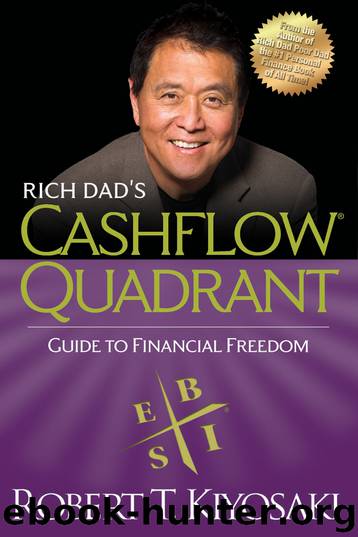Rich Dad's CASHFLOW Quadrant by Robert T. Kiyosaki

Author:Robert T. Kiyosaki
Language: eng
Format: epub, mobi
ISBN: 9781612680071
Publisher: Plata Publishing, LLC.
Published: 2015-11-08T05:00:00+00:00
And this is how your savings and your checkbook balance are carried on your bank’s balance sheet:
Why are your savings and checkbook balances a liability to banks? Because they have to pay you interest for your money, and it costs them money to safeguard it.
If you can grasp the significance of these few drawings and words, you might begin to better understand what the eyes cannot see about the game of money.
Why You Don’t Get a Tax Break for Saving Money
If you notice, you get a tax break for buying a house and going into debt, but you don’t get a tax break for saving money. Have you ever wondered why?
I’m not sure either, but I imagine that one big reason is because your savings are a liability to banks. Why would they ask the government to pass a law that would encourage you to put even more money in their bank, money that is a liability to them?
They Don’t Need Your Savings
Besides, banks really don’t need your savings. They don’t need much in deposits because they can magnify money at least 10 times. If you put $1 in the bank, by law, the bank can lend out $10 and, depending upon the reserve limits imposed by the central bank, possibly much more. That means your single $1 suddenly becomes $10 or more. It’s magic! When my rich dad showed me that, I fell in love with the idea. At that point, I knew that I wanted to own a bank and not go to school to become a banker.
On top of that, the bank may pay less than one percent interest on that one dollar. In better economic times, it could be five percent and you, as a consumer, would feel secure because the bank is paying you something on your money. Banks see this as good customer relations because, if you have savings with them, you may come in and borrow money too. They want you to do this because they can then charge nine percent or more on what you borrow. While you may make less than one percent on your $1, the bank can make nine percent or more on the $10 of debt your single dollar has generated. Recently, I received a new credit-card offer that advertised 8.9 percent interest. But since I understood the legal jargon in the fine print, I saw it was really 23 percent. Needless to say, I took a pass.
They Get Your Savings Anyway
The other reason they don’t offer a tax break for savings is more obvious. If you can read the numbers and see which way the cash is flowing, you’ll notice that they’ll get your savings anyway. The money you could be saving in your asset column is flowing instead out of your liability column in the form of interest payments on your mortgage. This ends up in the bank’s asset column. The cash-flow pattern looks like this:
Download
Rich Dad's CASHFLOW Quadrant by Robert T. Kiyosaki.mobi
This site does not store any files on its server. We only index and link to content provided by other sites. Please contact the content providers to delete copyright contents if any and email us, we'll remove relevant links or contents immediately.
| Budgeting & Money Management | College & Education Costs |
| Credit Ratings & Repair | Retirement Planning |
The Compound Effect by Darren Hardy(8808)
Tools of Titans by Timothy Ferriss(8215)
Nudge - Improving Decisions about Health, Wealth, and Happiness by Thaler Sunstein(7615)
Win Bigly by Scott Adams(7094)
Deep Work by Cal Newport(6877)
Rich Dad Poor Dad by Robert T. Kiyosaki(6399)
Pioneering Portfolio Management by David F. Swensen(6226)
Principles: Life and Work by Ray Dalio(6204)
The Barefoot Investor by Scott Pape(5698)
Digital Minimalism by Cal Newport;(5661)
Grit by Angela Duckworth(5512)
The Slight Edge by Jeff Olson(5346)
Discipline Equals Freedom by Jocko Willink(5281)
The Motivation Myth by Jeff Haden(5155)
You Are a Badass at Making Money by Jen Sincero(4866)
The Four Tendencies by Gretchen Rubin(4544)
Eat That Frog! by Brian Tracy(4431)
The Confidence Code by Katty Kay(4187)
Bullshit Jobs by David Graeber(4094)
